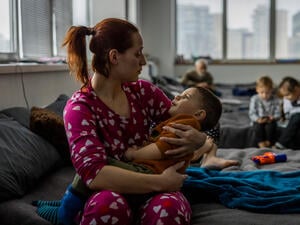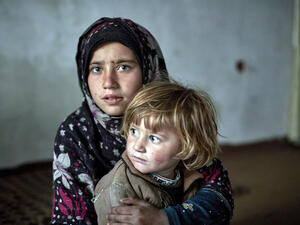With 1 human in every 113 affected, forced displacement hits record high
With 1 human in every 113 affected, forced displacement hits record high
Conflict and persecution caused global forced displacement to escalate sharply in 2015, reaching the highest level ever recorded and representing immense human suffering, according to a report released today by UNHCR, the UN Refugee Agency.
UNHCR’s annual Global Trends report, which tracks forced displacement worldwide based on data from governments, partners including the Internal Displacement Monitoring Centre, and the organization’s own reporting, said 65.3 million people were displaced as of the end of 2015, compared to 59.5 million just 12 months earlier. This is the first time that the threshold of 60 million has been crossed.
The total of 65.3 million comprises 3.2 million people in industrialized countries who as of end 2015 were awaiting decisions on asylum (the largest total UNHCR has recorded), 21.3 million refugees worldwide (1.8 million more than in 2014 and the highest refugee total since the early 1990s), and 40.8 million people who had been forced to flee their homes but were within the confines of their own countries (an increase of 2.6 million from 2014 and the highest number on record).
Measured against Earth’s 7.349 billion population, these numbers mean that 1 in every 113 people globally is now either an asylum-seeker, internally displaced or a refugee – a level of risk for which UNHCR knows no precedent. In all, there are more forcibly displaced people today than the populations of the United Kingdom, France or Italy.*
Forced displacement has been on the rise since at least the mid-1990s in most regions, but over the past five years the rate of climb has increased. The reasons are threefold: Situations that cause large refugee outflows are lasting longer (for example, conflicts in Somalia or Afghanistan are now into their third and fourth decades, respectively), dramatic new or reignited situations are occurring frequently (today’s largest being Syria, but also in the space of the past five years South Sudan, Yemen, Burundi, Ukraine, Central African Republic, etc.), and the rate at which solutions are being found for refugees and internally displaced people has been on a falling trend since the end of the Cold War. As recently as 10 years ago, at the end of 2005, UNHCR recorded an average of six people displaced every minute. Today that number is 24 per minute – almost double the typical frequency at which adults breathe.
“More people are being displaced by war and persecution and that’s worrying in itself, but the factors that endanger refugees are multiplying too,” said UN High Commissioner for Refugees Filippo Grandi. “At sea, a frightening number of refugees and migrants are dying each year; on land, people fleeing war are finding their way blocked by closed borders. Politics is gravitating against asylum in some countries. The willingness of nations to work together not just for refugees but for the collective human interest is what’s being tested today, and it’s this spirit of unity that badly needs to prevail.”
3 countries produce half the world’s refugees…
Among countries covered by the Global Trends report several stand out: Syria at 4.9 million, Afghanistan at 2.7 million and Somalia at 1.1 million together accounted for more than half the refugees under UNHCR’s mandate worldwide. Colombia at 6.9 million, Syria at 6.6 million, and Iraq at 4.4 million meanwhile had the largest numbers of internally displaced people. Yemen was the biggest producer of new internal displacement in 2015 – 2.5 million people, or 9 per cent of its population.
… And they’re mostly in the Global South
Europe’s struggles to manage the more than one million refugees and migrants who arrived via the Mediterranean dominated the attentions of many in 2015, nonetheless the report shows that the vast majority of the world’s refugees were elsewhere. In all, 86 per cent of refugees under UNHCR’s mandate in 2015 were in low and middle income countries close to situations of conflict. This figure rises to over 90 per cent of the world’s refugee total if the Palestinian refugees under the responsibility of UNHCR’s sister-organization UNRWA are included. Worldwide, Turkey was the biggest host country with 2.5 million refugees. Lebanon, meanwhile hosted more refugees compared to its population than any other country (183 refugees per 1,000 inhabitants). Relative to the size of its economy the Democratic Republic of the Congo hosted most (471 refugees for every dollar of per capita GDP, measured at price purchasing parity).
Asylum claims rise
Among industrialized countries, 2015 was also a record year for new asylum claims, with two million requests (contributing to the 3.2 million cases still pending as of the end of the year). Germany received more asylum requests than any other country (441,900), largely reflecting its readiness to receive people who were fleeing to Europe via the Mediterranean. The United States had the second highest number of asylum claims (172,700), many of these individuals fleeing gang-related violence in Central America. Substantial asylum applications were also seen in Sweden (156,000) and Russia (152,500).
About half the world’s refugees are children
Children constituted 51 per cent of the world’s refugees in 2015 according to the data UNHCR was able to gather (complete demographic data was not available to the report authors). Worryingly, many were separated from their parents or travelling alone. In all there were 98,400 asylum requests from children who were unaccompanied or separated from their families. This is the highest total UNHCR has seen – and a tragic reflection of how global forced displacement is disproportionately affecting young lives.
Unable to go home
While global displacement totals were higher than ever, the number of people able to return to their home or find another solution (local integration in a country of first refuge or resettlement elsewhere) was low. 201,400 refugees were able to return to their countries of origin in 2015 (mainly Afghanistan, Sudan and Somalia). This was higher than the total in 2014 (126,800), but still substantially down compared with the peaks of the early 1990s. Some 107,100 refugees were admitted for resettlement in 30 countries in 2015 – representing just 0.66 per cent of the refugees under UNHCR’s mandate (by comparison, 26 countries admitted 105,200 refugees for resettlement in 2014, representing 0.73 per cent of the refugee population under UNHCR care). At least 32,000 refugees became naturalized over the course of the year, the majority in Canada and with smaller numbers in France, Belgium, Austria and elsewhere.
Displacement at end 2015, by region (from highest to lowest)
1. Middle East and North Africa
Syria’s war remained the world’s leading cause of displacement and associated suffering. By the end of 2015 it had driven at least 4.9 million people into exile as refugees and displaced 6.6 million internally – amounting to around half Syria’s pre-war population. Iraq’s conflict had by year’s end displaced 4.4 million people internally and created more than a quarter of a million refugees. Yemen’s civil war, which began in 2015, had by the end of December displaced 2.5 million people – more new displacement than any other conflict globally. Including the 5.2 million Palestinian refugees under the mandate of UNRWA, the almost half a million Libyans forced to flee their homes and remaining in the country, plus a number of smaller situations, the Middle East and North Africa region accounted for more displacement than any other.
2. Sub-Saharan Africa
Sub-Saharan Africa had the largest displacement totals in 2015 after the Middle East and North Africa. Continuing bitter conflict in South Sudan in 2015, as well as in Central African Republic and Somalia, plus new or continuing mass displacement in or from countries including Nigeria, Burundi, Sudan, Democratic Republic of the Congo, Mozambique and elsewhere together produced 18.4 million refugees and internally displaced people as of year’s end. Sub-Saharan Africa meanwhile hosted some 4.4 million refugees in all – more than any other region. Five of the world’s top-10 hosting nations were African countries, led by Ethiopia, and followed by Kenya, Uganda, Democratic Republic of the Congo and Chad.
3. Asia and Pacific
The Asia and Pacific region accounted for almost a sixth of the world’s refugees and internally displaced people in 2015, making it the third largest region for displacement overall. One in six of the refugees under UNHCR’s mandate were from Afghanistan (2.7 million people) where almost 1.2 million people were internally displaced. Myanmar was the region’s second largest producer of both refugees and internally displaced people (451,800 and 451,000 respectively). Pakistan (1.5 million) and Islamic Republic of Iran (979,000) remain among the world’s leading refugee hosting countries.
4. Americas
Rising numbers of people fleeing gang and other violence in Central America contributed to a 17 per cent rise in displacement across the wider region. Refugees and asylum seekers from El Salvador, Guatemala, and Honduras together reached 109,800, most coming to Mexico and the United States and representing a more than five-fold increase over three years. Colombia, a longstanding situation, remained the world’s biggest country for internal displacement (6.9 million).
5. Europe
Europe’s proximity to Syria and Iraq, the arrival of more than a million refugees and migrants via the Mediterranean mostly from the world’s top ten refugee-producing countries, and the situation in Ukraine, together dominated the region’s displacement picture in 2015. At the end of 2015 there were some 593,000 refugees from European countries – more than half from Ukraine. European countries also hosted 4.4 million refugees – 2.5 million of them in Turkey. Figures provided by the Government of Ukraine list 1.6 million Ukrainians as being displaced there. The Global Trends report lists 441,900 asylum claims in Germany, where the refugee population increased by 46 per cent from its 2014 level to 316,000.
Additional Information
UNHCR’s Global Trends Report is being released on World Refugee Day, 20 June, in conjunction with our #WithRefugees petition campaign. A full multimedia package is available in connection with the Global Trends report, including infographics, photos, video materials and other products. The package, plus details of UNHCR’s global media contacts, can be found here.
* 2015 population of UK: 64.7 million; population of France: 64.4 million; population of Italy 59.8 million. Source: UN Population Division, World Population Prospects, the 2015 Revision








